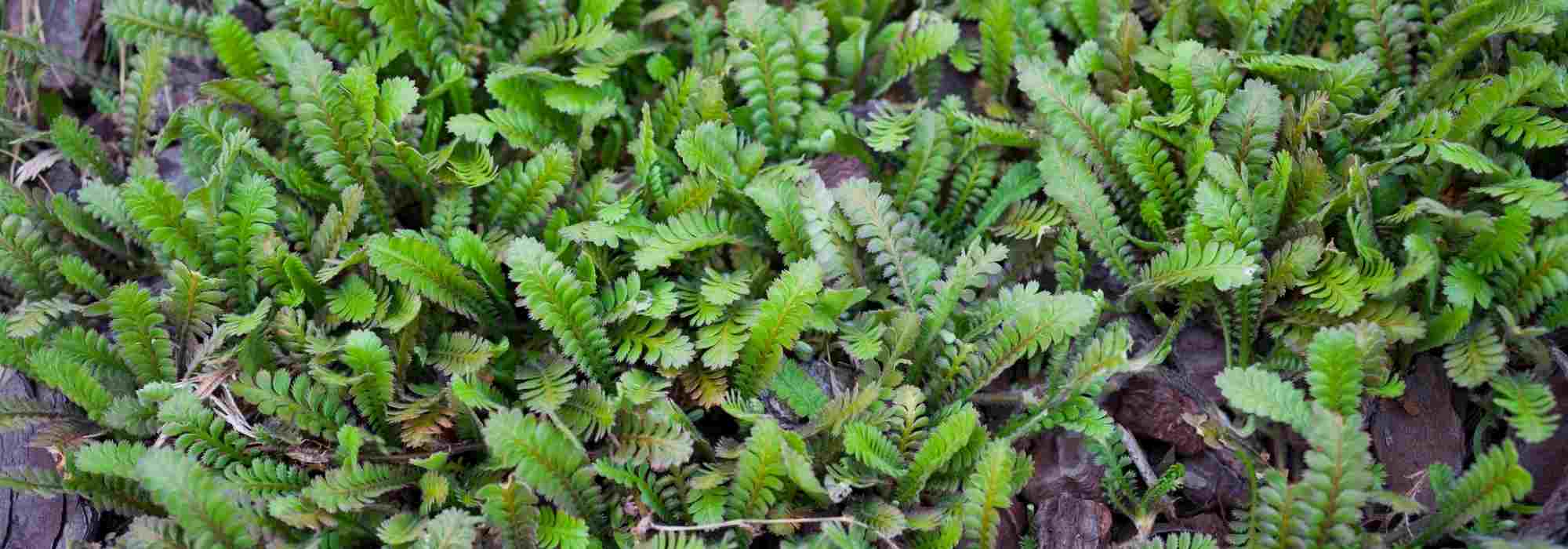
How to combine Leptinella or Cotula?
A groundcover that deserves to be known
Contents
Leptinellas or button ferns are hardy groundcover perennials to grow in partial shade in cool, well-drained soil. The foliage of these perennials resembles that of a fern and can take on bronze to purple hues, sometimes very dark. They are hardy, trouble-free and quickly colonise shady rockeries, the gaps between slabs or stones, or the base of trees and bushes. Here are some pairing ideas to welcome leptinellas into your garden.
A beautiful shady damp rockery
A rockery is not always designed in full sun with dry soil plants. A rockery can also be found in shade and host plants from moist environments, but that appreciate relatively well-drained soils. This type of rockery will fit quite naturally in a woodland area near a small stream. It is advisable to favour perennials with beautiful foliage, punctuated here and there by one or two colourful touches provided by flowers.
Some clumps of Potentilla cotula (Leptinella potentinella) will work wonders alongside a handful of ferns, such as beautiful bamboo ferns (Coniogramma emeiensis) or, more classic yet equally spectacular, scolopendria (Phyllitis scolopendrium). The charming, yet remarkably effective Saxifraga stolonifera ‘Cuscutiformis’ will add a touch of lightness with their floral spikes bearing soft, atypical white flowers. The choice is vast, but hostas will thrive in this type of rockery alongside a handful of epimediums. Their foliage is enhanced in season by beautiful inflorescences.
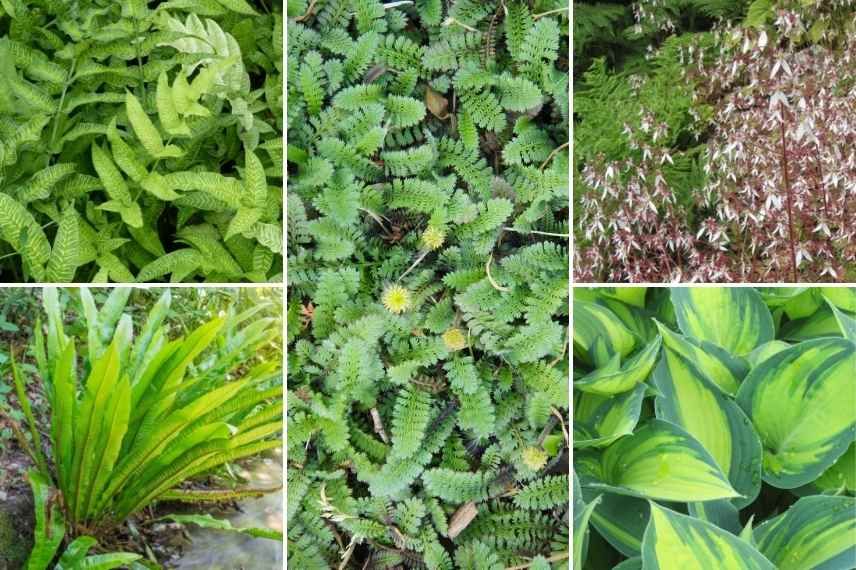 Leptinella potentinella in the centre surrounded in a shady rockery by bamboo fern (top left), scolopendria, Saxifraga stolonifera ‘Cuscutiformis’ and Hosta ‘June’
Leptinella potentinella in the centre surrounded in a shady rockery by bamboo fern (top left), scolopendria, Saxifraga stolonifera ‘Cuscutiformis’ and Hosta ‘June’
An original groundcover under trees
Leptinellas or cotules thrive well as groundcover under trees, provided the shade is not too dense and the soil does not dry out too much in summer. Trees with a light branching habit or pruned for transparency provide beneficial dappled shade without plunging the plants at their feet into darkness.
One of the most beautiful cotules is undoubtedly Leptinella squalida ‘Patt’s Black’, which will form a carpet of “fern-like” foliage in a lovely dark bronze-purple hue. To echo the foliage of the bracted cotule, some clusters of small ferns, such as Athyrium niponicum ‘Pictum’, will be ideal. This creates a shape reminder with the athyriums, as well as a colour reminder between the purple-bronze foliage of the leptinellas and the deep purple foliage of two or three Oriental hellebores ‘Black Chocolate’ with almost black flowers. Finally, small tufts scattered here and there of Caucasian forget-me-not ‘Jack Frost’ will enhance the dark aspect of the leptinellas with a lovely contrast through their almost silver foliage.
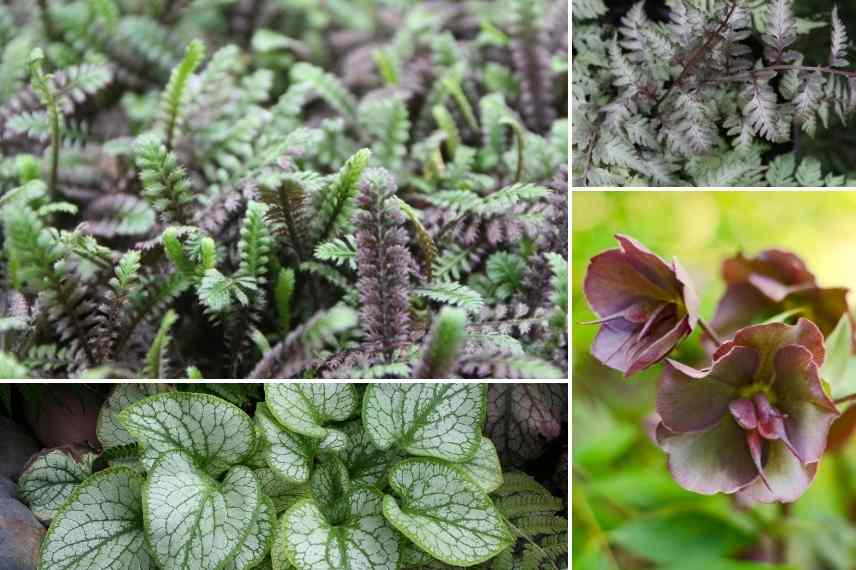
Leptinella squalida ‘Patt’s Black’, Brunnera macrophylla ‘Jack Frost’, Athyrium niponicum ‘Pictum’ and a very dark oriental hellebore to integrate into this lovely scene under the trees
Discover other Leptinella
View all →Available in 1 sizes
Available in 2 sizes
Available in 1 sizes
Available in 2 sizes
Available in 1 sizes
A small Japanese-style flowerbed
A semi-shaded area and relatively acidic soil: why not try a small Japanese-style bed? Just choose Japanese species and keep in mind a certain simplicity. Avoid at all costs copying existing Japanese gardens by reducing them to the size of your garden. It will be a resounding failure. Keep it simple, understated, and effective!
At the centre of this bed, a beautiful Japanese maple like this elegant Acer palmatum ‘Shaina’ will proudly stand. Small Japanese azaleas ‘Hino Crimson’, shaped like little cushions, will provide a spring flowering of bright red reminiscent of the maple’s foliage. A beautiful Japanese camellia will make a statement: the small size of the Camellia japonica ‘Valtevareda’ allows it to fit into small spaces, and its large pink flowers are hard to miss. If part of the bed is sunnier, a small Japanese conifer like the Pinus parviflora ‘Negishi’ could be planted there. This small pine (no more than 2 m tall) has bluish-green foliage and an irregular habit that gives it the appearance of a venerable conifer.
And what about the leptinellas, you may ask? Well, Japanese or Japanese-style gardens favour minerals, but also moss gardens. If moss doesn’t appeal to you, you can advantageously replace it with a carpet of Leptinella, particularly the adorable Leptinella dioica ‘Minima’. A small, carpet-forming leptinella, less than 3 cm tall, with evergreen green foliage that turns brown in winter.
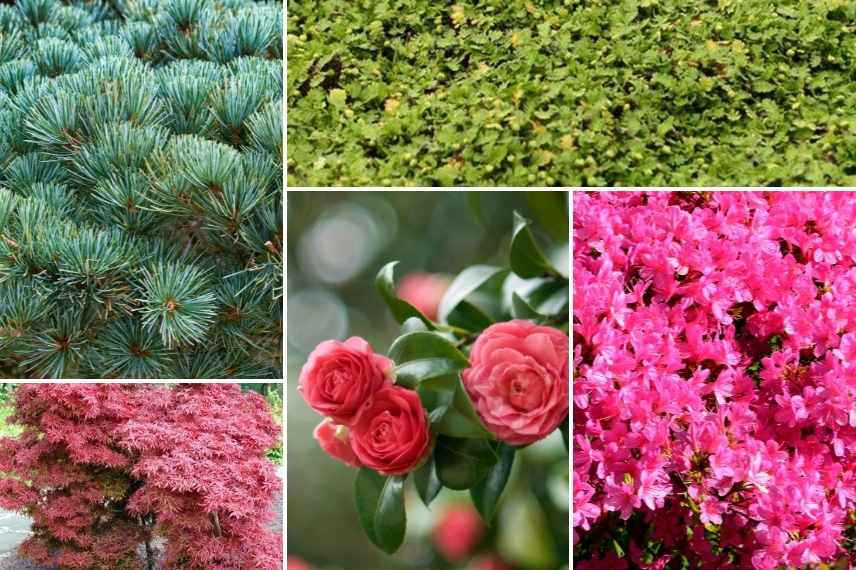 Leptinella dioica ‘Minima’ in the top right, associated with a Pinus parviflora ‘Negishi’ with bluish foliage, an Acer palmatum ‘Shaina’, a beautiful camellia, and an azalea ‘Hino Crimson’
Leptinella dioica ‘Minima’ in the top right, associated with a Pinus parviflora ‘Negishi’ with bluish foliage, an Acer palmatum ‘Shaina’, a beautiful camellia, and an azalea ‘Hino Crimson’
In pots: Romantic atmosphere
Leptinellas grow very well in pots, provided you remember to water them during periods of severe drought. They can adorn window boxes or troughs, but they can also form a lovely ground cover at the base of a bush.
A few small clumps of Leptinella squalida will happily accompany the base of a slow-growing, slightly twisted Japanese cherry: the Prunus incisa ‘Kojo No Mai’. This small tree should be planted in a large pot of about 20 litres to allow it to develop over a few years. To add rhythm to the display, ferns will fit in perfectly: I particularly think of small Athyrium ‘Ghost’, hybrid ferns with fronds revealing a bluish-silver, almost metallic look. A variegated ivy with silver-grey-green, Hedera helix ‘Glacier’, will cascade down from the pot, giving the whole arrangement a very natural appearance.
→ Discover our tips on how to grow Leptinella in pots

Leptinella squalida, Hedera helix ‘Glacier’, Athyrium ‘Ghost’ and Prunus incisa ‘Kojo No Mai’
Fill the gaps between the stones, the slabs...
Not really an idea for a combination, but rather a landscaping idea: Leptinella dioica ‘Minima’ is perfect for fitting into the smallest gaps between stones, paving, slabs… It will thrive in partial shade or shade in a cool environment. Consider it if you want to add a little green and romantic touch to your pavements.
- Subscribe!
- Contents




































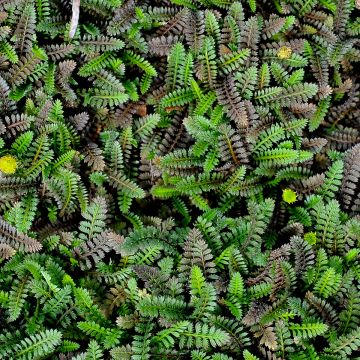
Comments